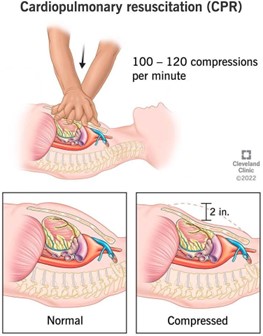Your patient has a CMP drawn to determine their electrolytes. Only part of the values have resulted including the Na+ which is 121 mEq/l. What type of electrolyte imbalance is the patient having?
Hypocalcemia
Hyperkalemia
Hypernatremia
Hyponatremia
The Correct Answer is D
Explanation: The normal range of sodium (Na+) in the blood is 135-145 mEq/L. The patient's sodium level of 121 mEq/L is below the normal range, indicating a low sodium level, which is called hyponatremia.
Hyponatremia is a common electrolyte imbalance that can be caused by a variety of factors, including excessive sweating, vomiting, diarrhea, certain medications, kidney disease, and hormonal imbalances. It can cause symptoms such as nausea, headache, confusion, seizures, and coma, and it can be a medical emergency if the sodium level drops rapidly or severely.
Nursing Test Bank
Naxlex Comprehensive Predictor Exams
Related Questions
Correct Answer is C
Explanation
CPR (Cardiopulmonary Resuscitation) is a life-saving procedure that is performed when a person's heart has stopped beating. It involves chest compressions and rescue breathing to restore the circulation of oxygenated blood to the brain and other vital organs. The timely initiation of CPR can significantly increase the chances of a patient's survival.
In a healthcare setting, UAPs/CNAs are often trained to provide basic life support, including initiating CPR, until a healthcare provider arrives. However, giving IV epinephrine, intubating the patient, and obtaining arterial blood gases are all advanced medical procedures that require specialized training and expertise. These actions should only be performed by trained healthcare providers, such as registered nurses, physicians, or respiratory therapists, and cannot be delegated to UAPs/CNAs.

Correct Answer is A
Explanation
The left ventricle is responsible for pumping oxygen-rich blood from the heart to the rest of the body. In heart failure, the left ventricle is weakened and unable to pump blood efficiently, resulting in reduced blood flow to the body's tissues. This can lead to symptoms such as fatigue, shortness of breath, and swelling in the legs and feet. Treatment for heart failure may include medications, lifestyle changes, and in some cases, surgical interventions such as a heart transplant.

Whether you are a student looking to ace your exams or a practicing nurse seeking to enhance your expertise , our nursing education contents will empower you with the confidence and competence to make a difference in the lives of patients and become a respected leader in the healthcare field.
Visit Naxlex, invest in your future and unlock endless possibilities with our unparalleled nursing education contents today
Report Wrong Answer on the Current Question
Do you disagree with the answer? If yes, what is your expected answer? Explain.
Kindly be descriptive with the issue you are facing.
